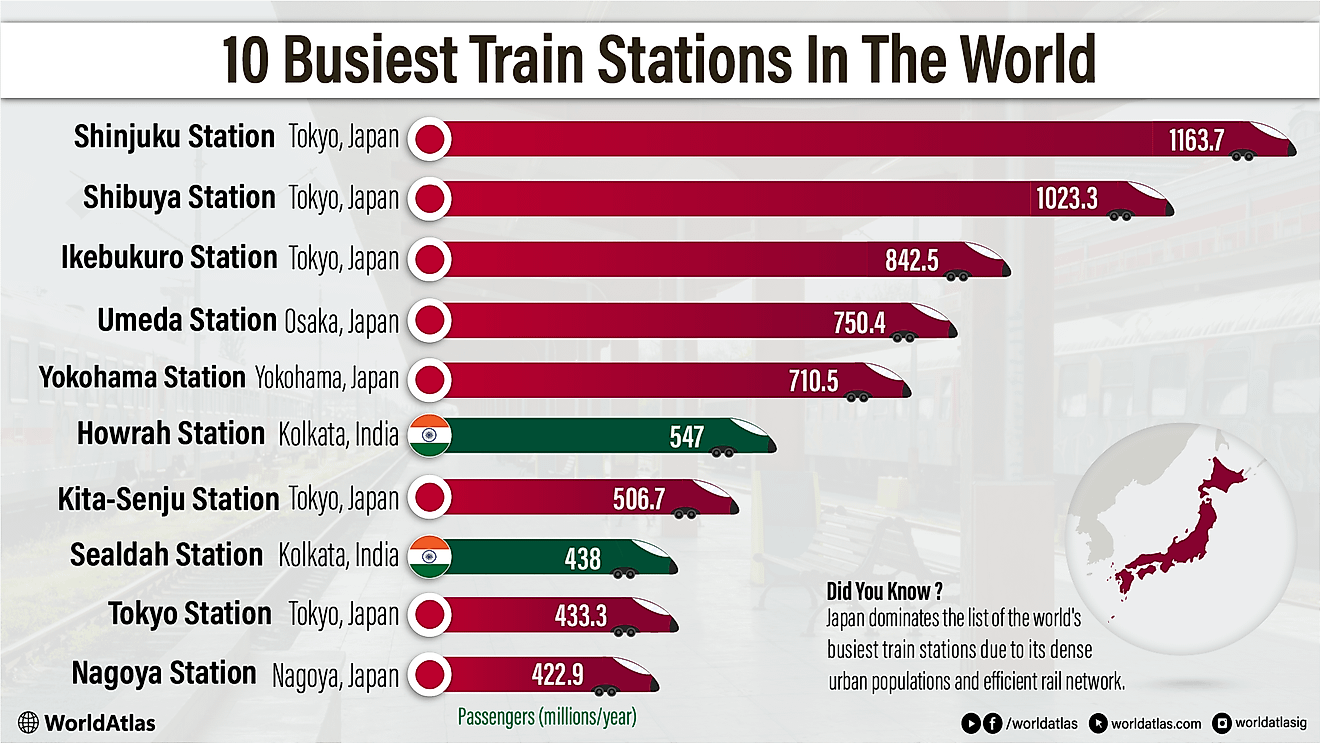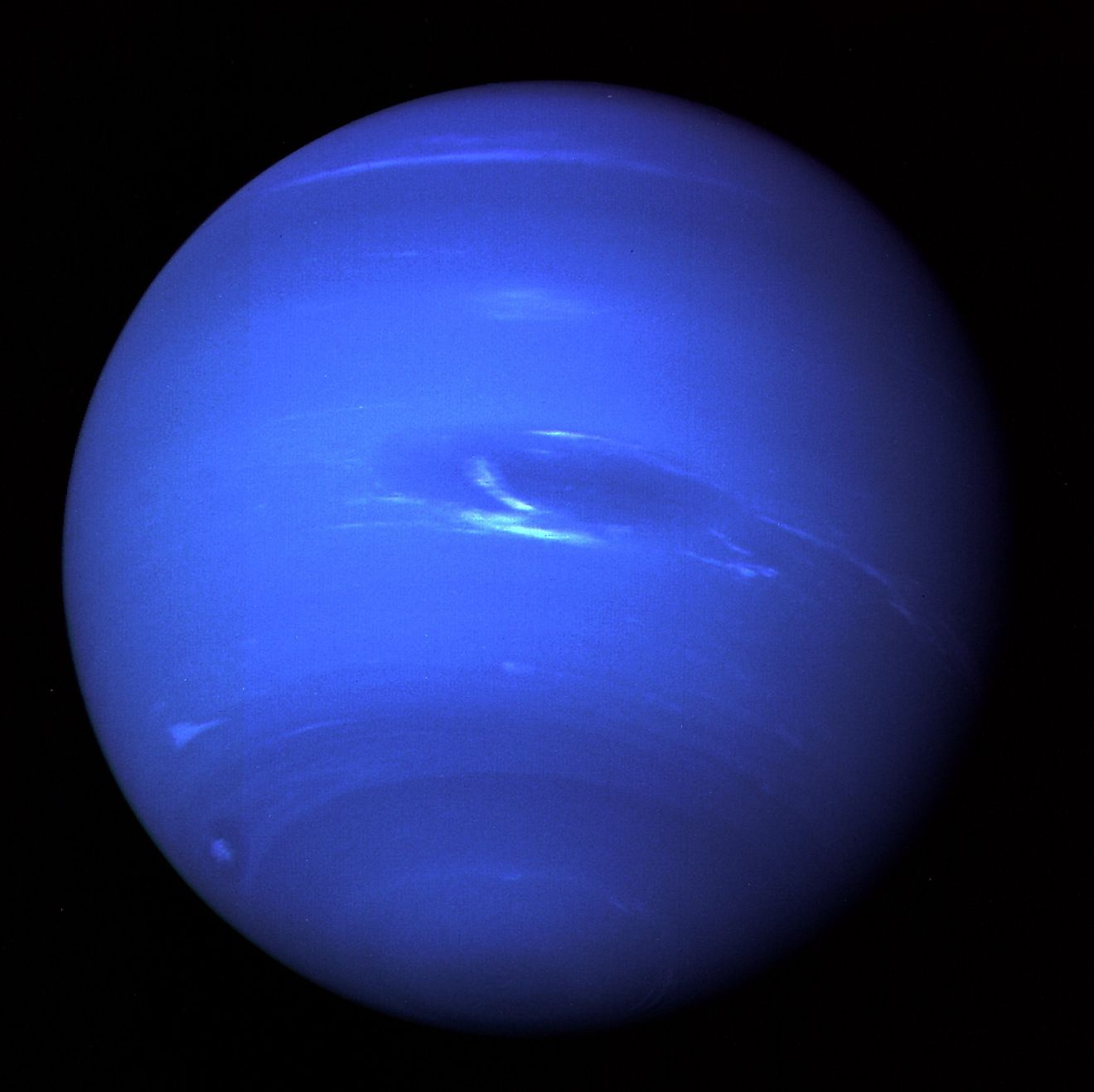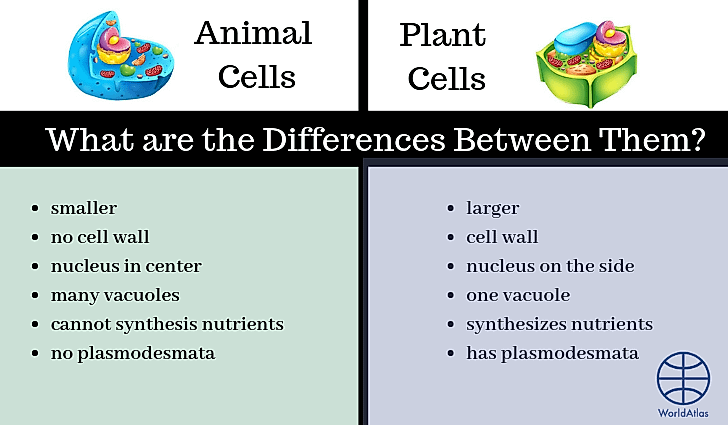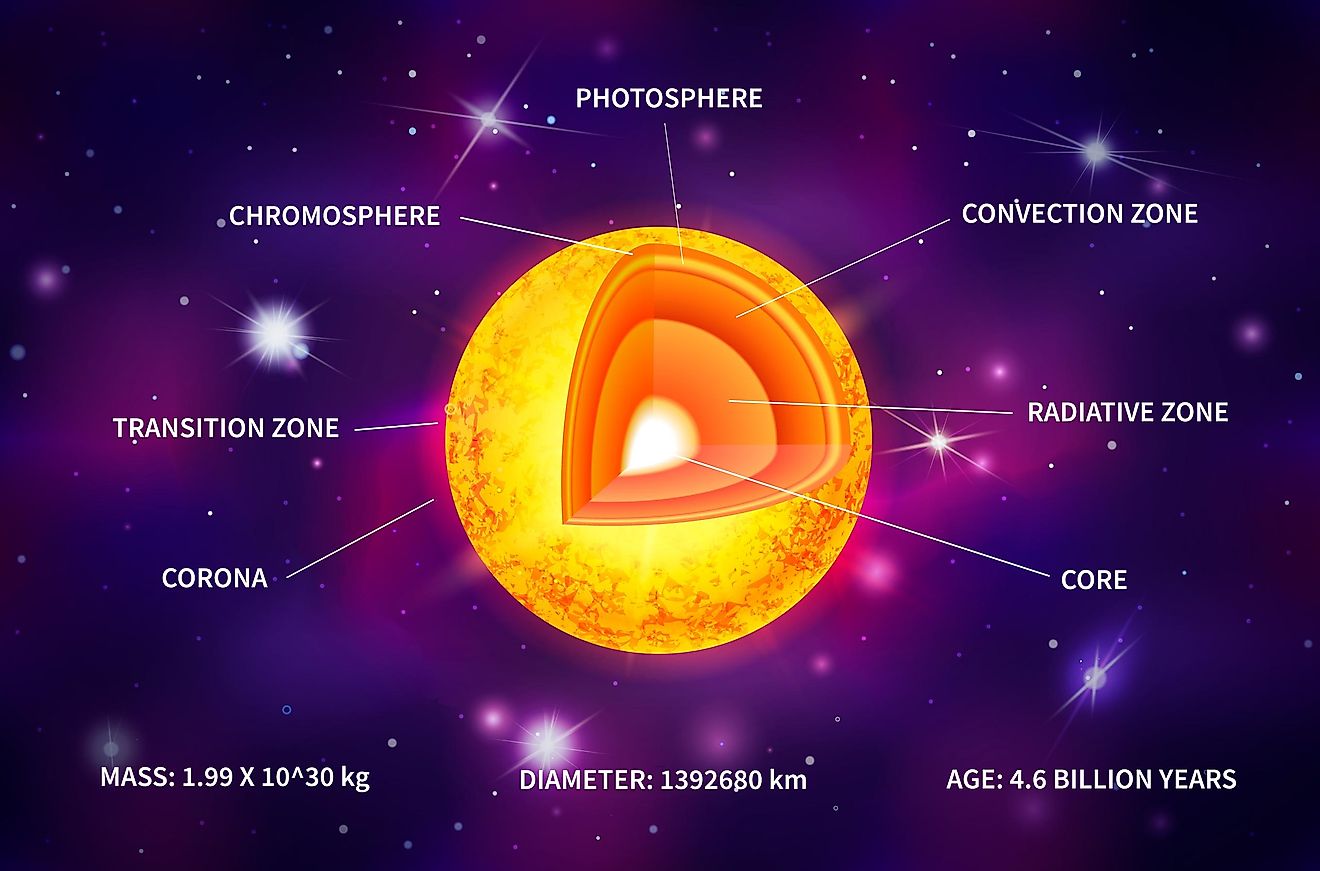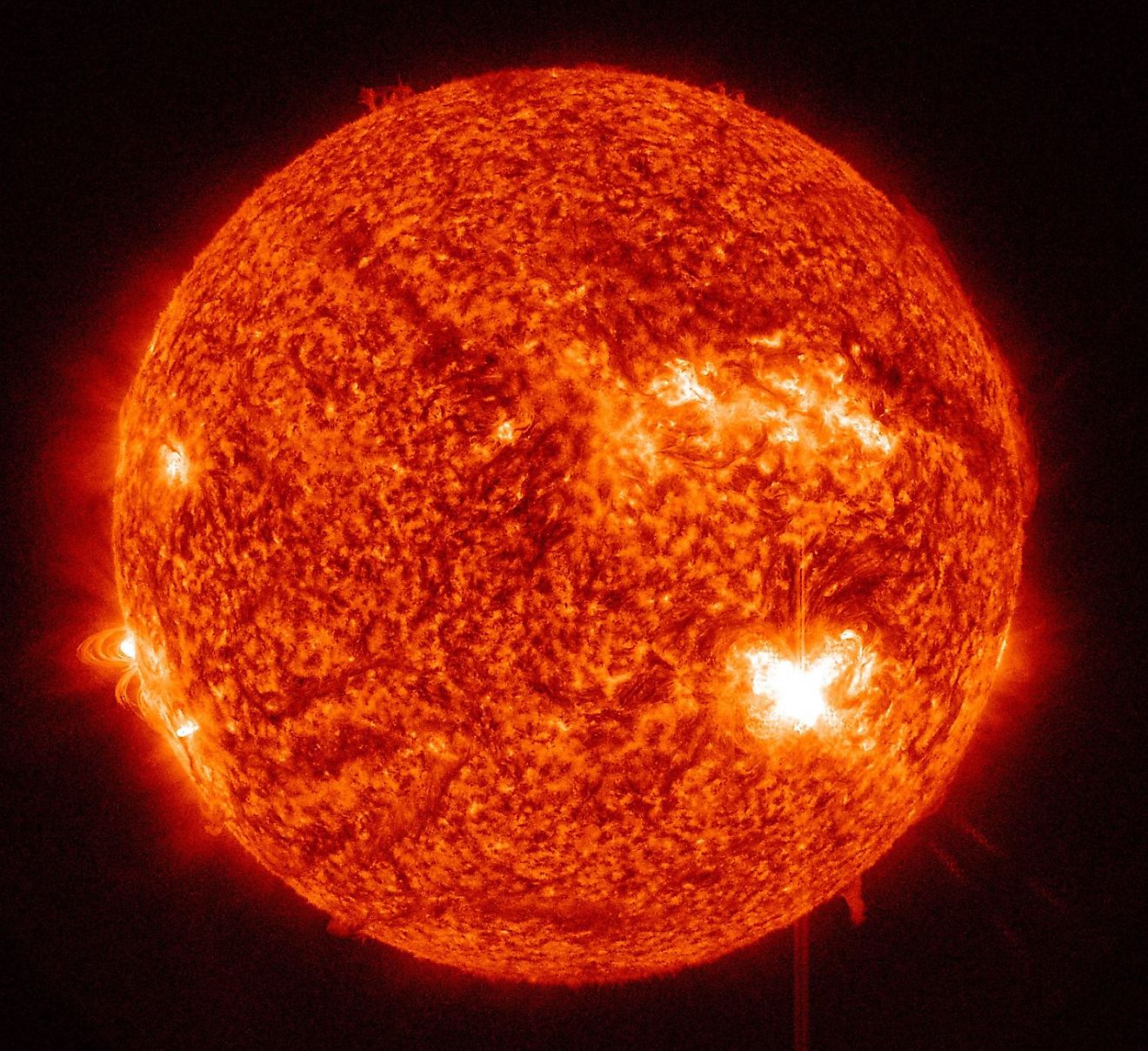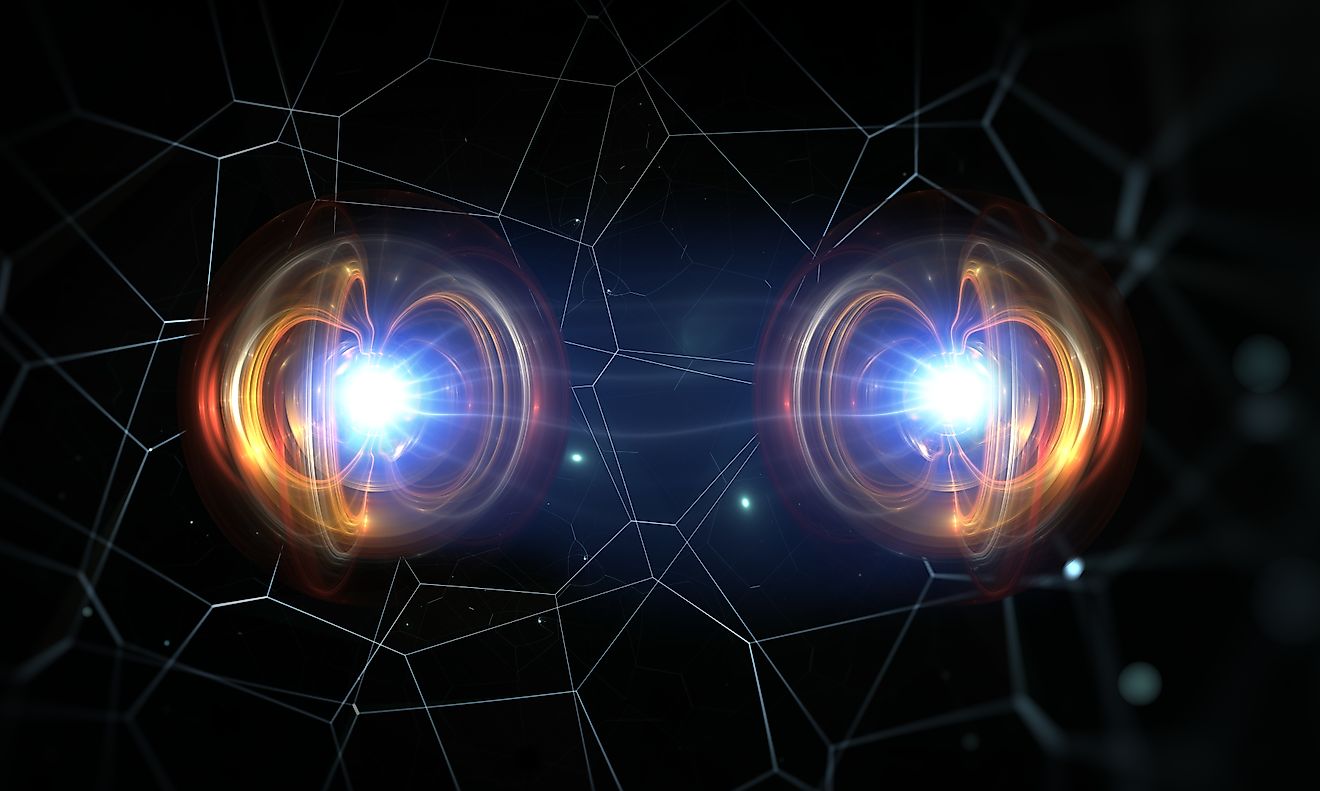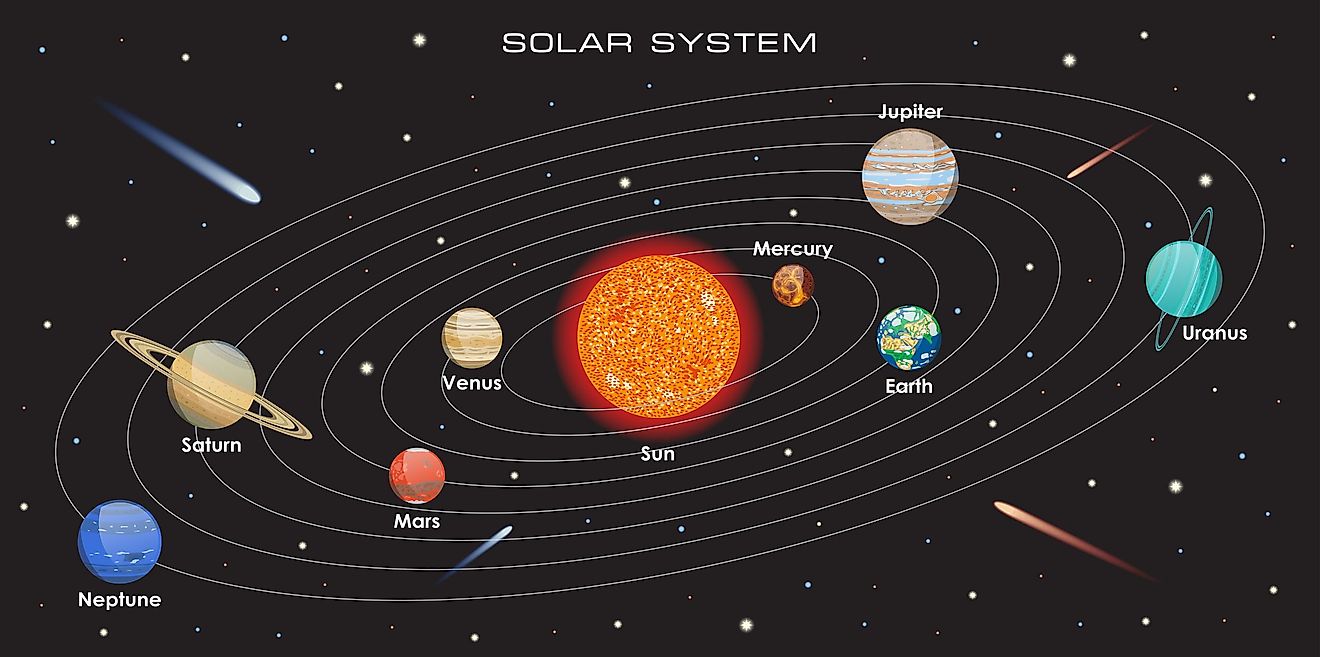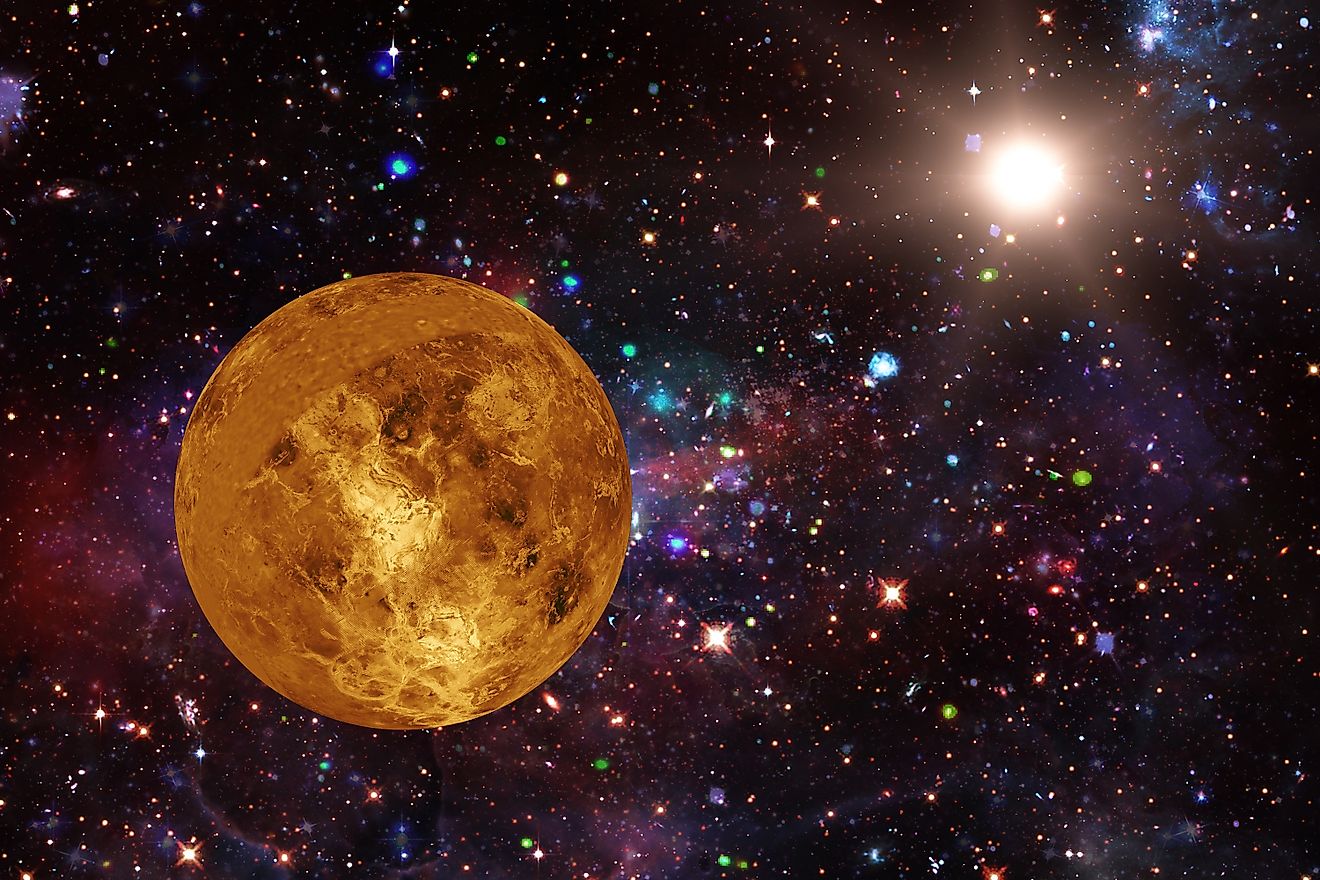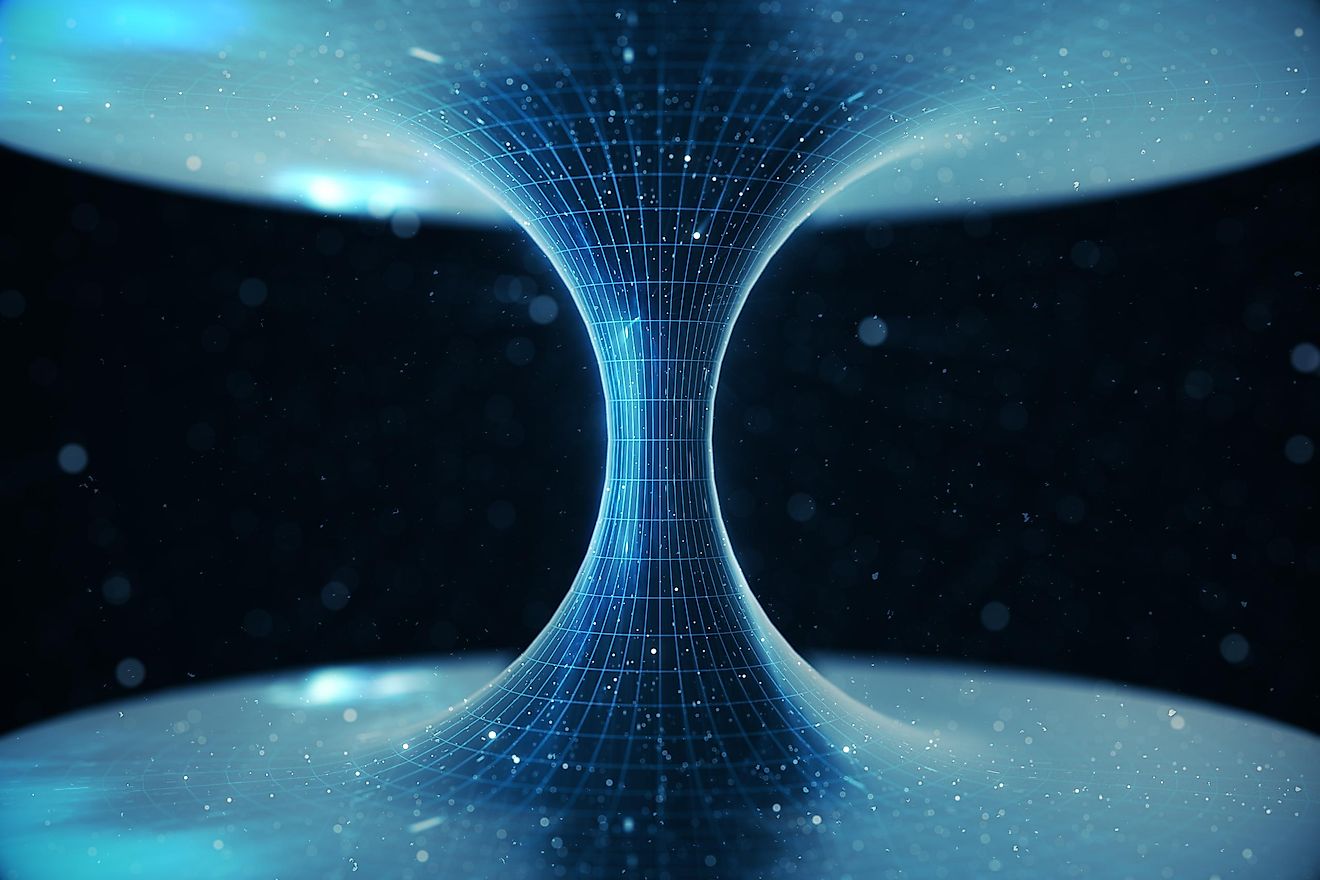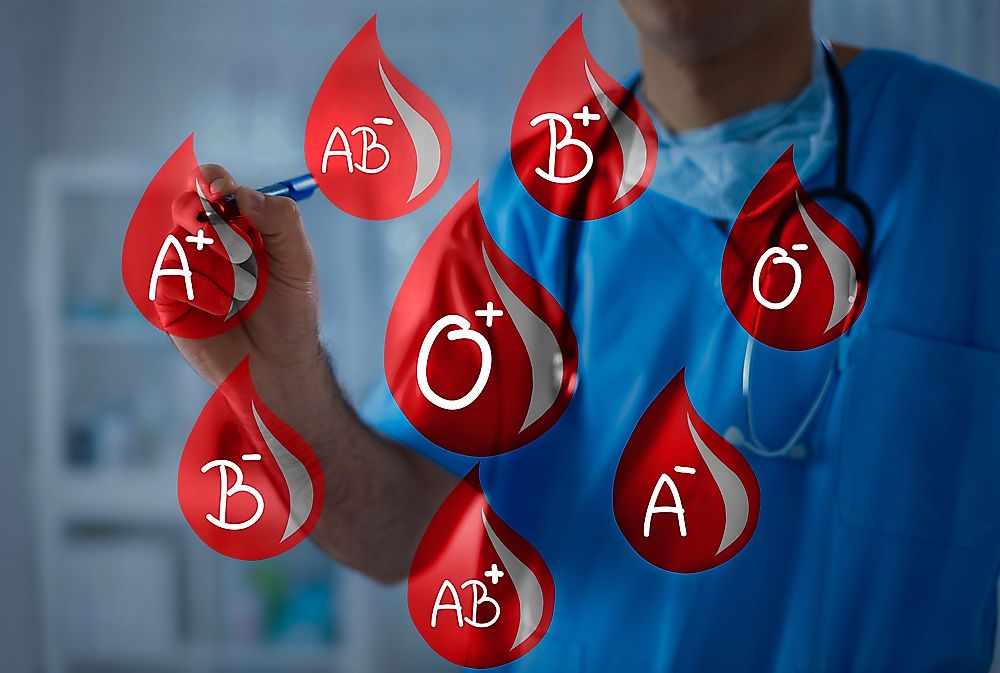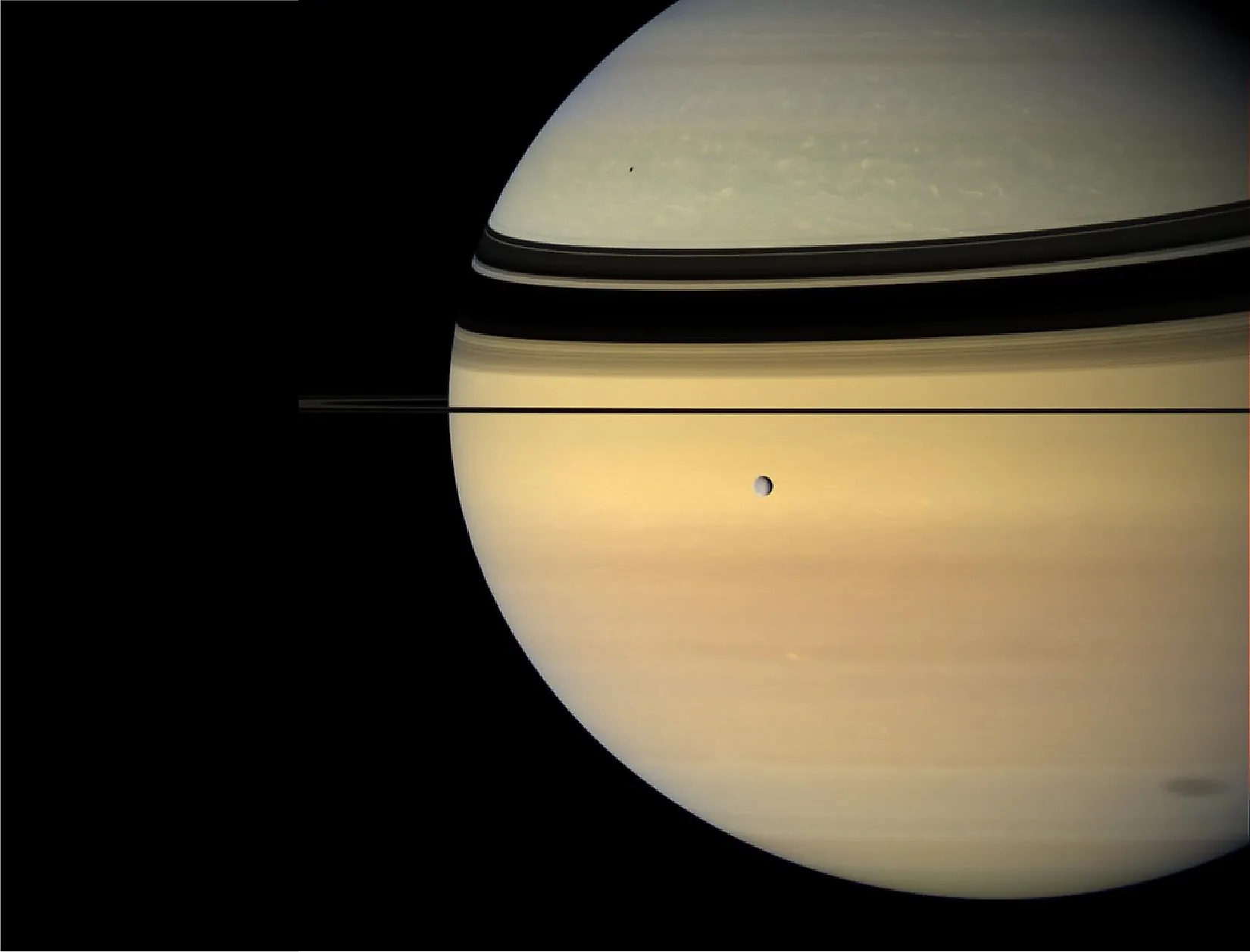
Saturn
Saturn orbits the sun at a distance of 886-million miles (1.4 billion kilometres). At such a vast distance from the primary source of heat in the solar system, Saturn experiences frigid temperatures in its upper atmosphere that can drop to as low as minus 292 degrees Fahrenheit (minus 180 degrees Celsius). Saturn is perhaps the solar system’s most brilliant sight. Even with just a small telescope, you can see Saturn’s rings wrapped around the gas giant.
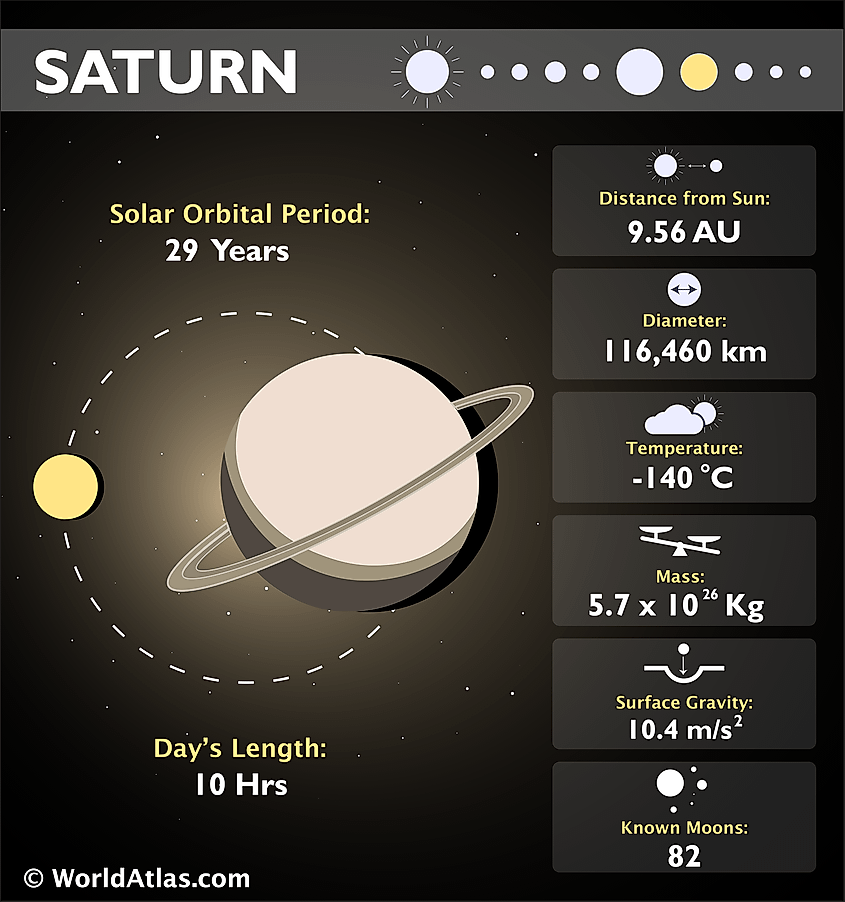
Properties Of Saturn
Suspended against the darkness of space, Saturn is truly a sight to behold. Saturn is the second largest planet in the solar system by size and mass. Saturn is 74,898 miles (120,536 kilometres) in diameter and 95 times heavier than the Earth. Interestingly, Saturn possesses the lowest density of any planet in the solar system, having a density even lower than that of water. Assuming you could turn its gravity off and find a large enough tub of water, Saturn would actually float. This low density is largely due to the fact that Saturn is mostly composed of the light elements, hydrogen and helium. Roughly 97% of Saturn is composed of hydrogen, with helium making up most of the other 3%.
Given its distance from the sun, it is no surprise that Saturn’s upper atmosphere is exceedingly cold. However, as you descend further into Saturn, temperatures begin to increase dramatically. Below the upper cloud layer is a layer of water ice that has a temperature range of minus 112 degrees Fahrenheit to 27 degrees Fahrenheit (minus 80 degrees Celsius to minus 3 degrees Celsius). Near the core of Saturn, astronomers predict that temperatures could become as high as 21,092 degrees Fahrenheit (11,700 degrees Celsius). This number is a prediction because we have yet to venture into Saturn’s deep interior. The temperature differences between Saturn’s upper and inner layers creates convection currents that drive the planet’s weather, creating storms that can grow larger than the Earth itself.
Saturn Vs. Jupiter
Like Jupiter, Saturn is mostly composed of hydrogen and helium. It may come as a surprise that two planets with so many similarities look so different from each other. Jupiter’s atmosphere is divided into large distinctive bands that can be seen with even a small telescope. Saturn on the other hand appears far more uniform, almost having a watered down appearance relative to Jupiter. Both Jupiter and Saturn have fast rotational periods, with Saturn completing one rotation every 10 hours. These extreme speeds stretch out gas in the atmosphere, creating the large atmospheric bands on Jupiter and Saturn.
Although Jupiter and Saturn are made of virtually the same material, the frigid temperatures at Saturn create a thick layer of ammonia ice crystals that sit on top of a layer of frozen water and ammonia. Jupiter also has these layers in its atmosphere, they’re just thicker and stretch deeper into Saturn than they do on Jupiter. It’s this layer of ammonia that gives Saturn its watered down appearance. Far below the cloud tops of Saturn is a layer of hydrogen that undergoes an interesting process. Under the extreme pressures and temperatures within Saturn, hydrogen atoms turn into a metallic fluid. Like a metal, this metallic hydrogen can conduct electricity. The moving electric charge generates a magnetic field around Saturn similar to the one around Jupiter. Beneath this layer of metallic hydrogen is the core of Saturn. Like Jupiter, the core of Saturn is its biggest mystery. Although Saturn likely began its life as a rocky world, it eventually accumulated enough mass to capture the lighter elements hydrogen and helium. As the planet grew to immense sizes, it’s possible that the rocky core of Saturn was slowly eroded away.
Observational History Of Saturn
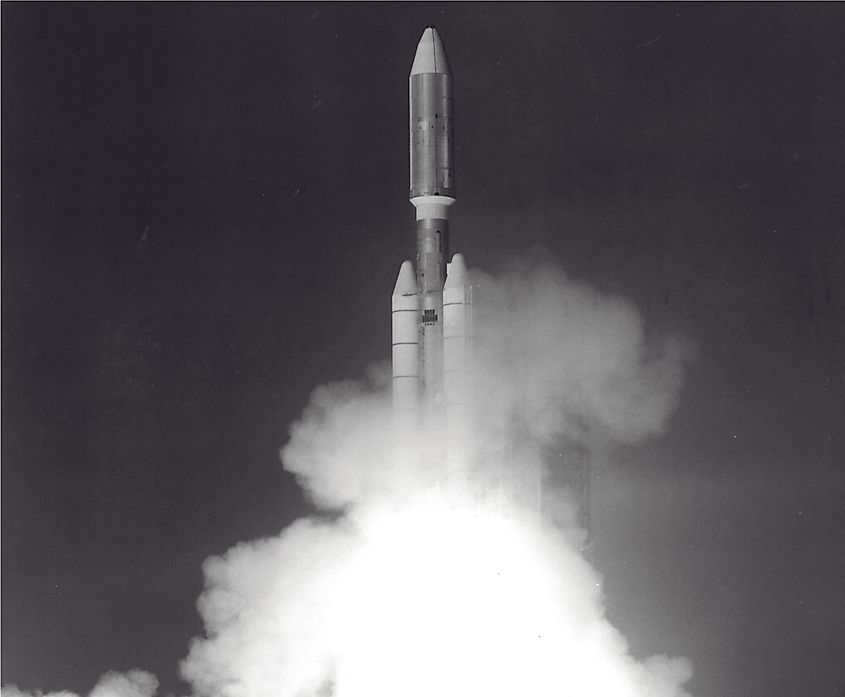
Saturn is the furthest planet from the sun that is visible to the naked eye, and thus its existence has been known since ancient times. The earliest recorded observations of Saturn come from Babylonian astronomers over 3,000 years ago. The Greeks and Romans associated the planet Saturn with agriculture, and the name Saturn comes from the Roman god of agriculture. Without telescopes, ancient cultures were unable to learn anything about Saturn, and it wasn’t until the 1600s that astronomers finally began to see Saturn for the stunning world that it is. In 1610, Galileo Galilei observed Saturn through his telescope. The telescope that Galileo used was relatively small, and so he was unable to identify any physical features of the planet. Galileo did observe Saturn’s rings, but his telescope was too small to discern them as rings. Rather, Galileo believed he had found two elongated moons on either side of Saturn. The first astronomer to correctly identify Saturn’s rings was Christiaan Huygens in 1655. In addition to Saturn’s rings, Huygens also discovered Saturn’s largest moon, Titan. In 1675, the astronomer Giovanni Cassini discovered a large gap in Saturn’s rings, which would later be called the Cassini Division. For the next two centuries, astronomers discovered several more moons around Saturn, yet pretty much everything about Saturn would remain a mystery until the 20th century.
In 1979, NASA’s Pioneer 11 spacecraft completed the first ever flyby of Saturn, offering scientists their first up-close view of Saturn and its rings. Unfortunately, the resolution of Pioneer 11’s images were too low to discern any surface features on Saturn’s moons. A year after Pioneer 11 completed its flyby, the Voyager 1 spacecraft would conduct its flyby of Saturn. Voyager 1 provided scientists with their first high resolution images of Saturn, its rings, and several of its moons. Voyager 1 also completed the first flyby of Titan, confirming the existence of its dense atmosphere. A year after Voyager 1, Voyager 2 completed its flyby of Saturn, offering more images of the planet and its moons.
The Voyager mission revealed that Saturn and its moons held countless mysteries. NASA soon began plans on a future mission to Saturn that would send a spacecraft to orbit the gas giant for years. In 1997, NASA launched the Cassini spacecraft. Cassini arrived at Saturn in 2004 and remained in orbit until 2017, when the spacecraft plunged into the atmosphere of Saturn. Most of what is known about Saturn, its rings, and its moons was revealed during the Cassini mission. The data that Cassini provided is beyond value.
Saturn’s Rings
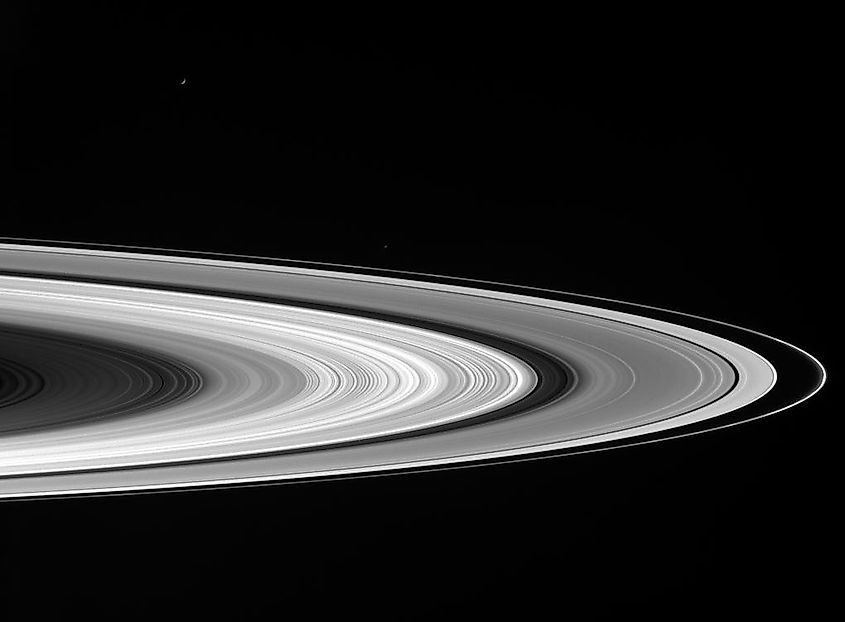
The rings of Saturn are truly one of the solar system’s most gracious and stunning sights. They are about 248,550 miles (400,000 kilometres) across yet only 328 feet (100 meters) thick. When Galileo first observed Saturn through a telescope in 1610, he assumed that he was observing two large moons on either side of Saturn. Then in 1655, astronomer Christian Huygens observed Saturn and correctly deduced that the planet was surrounded by a ring. However, early astronomers believed that the ring was solid, and it definitely appears that way when observed through a small telescope. The first indication that the rings weren’t solid came in 1675, when Giovanni Cassini discovered a large gap in Saturn’s ring, which became known as the Cassini division, yet the prevailing assumption was that the ring was still solid. Although there were a small number of astronomers who disagreed with these assumptions, their ideas were not overly popular.
It would not be until 1859 that scientists would show that the rings could not be solid. In 1859, physicist James Clerk Maxwell showed that a solid, uniform ring around Saturn simply could not exist under the laws of physics. He showed that Saturn’s gravity would push more strongly on the inner section of the ring than on the outer regions, and thus gravity itself would simply rip it apart. In order for a ring to exist around Saturn, it must be composed of countless particles all in orbit around Saturn. Although this explanation was the most logical and followed the laws of physics, it wouldn’t be until the Pioneer 11 flyby of Saturn in 1979 that astronomers would get their first up-close view of Saturn and its rings. A year later, Voyager 1 would complete its flyby of Saturn. Both flybys confirmed without a doubt that Saturn’s rings were composed of countless particles primarily made of water and rock. Today, we’re fortunate enough to have the most detailed views of Saturn’s rings, the result of the Cassini mission, which orbited the ringed planet from 2004 until 2017.
Saturn’s ring system is divided into several separate rings, the most notable of which are designated as the D, C, B, A, F, G, and E ring. Within Saturn’s outermost E-ring orbits the icy moon Enceladus, which may be the reason why Saturn has an E-ring at all. Unlike the other rings, the E-ring is entirely composed of microscopic particles of ice. These tiny particles of ice erupted from the surface of Enceladus, where cryovolcanoes have been observed erupting large amounts of ice into space. Some of the ice falls back onto the surface of Enceladus as a fresh coating of snow. The rest of the material falls into orbit around Saturn and forms its E-ring.
Where did Saturn’s rings come from? How old are they? And why don’t any other planets in our solar system have ring systems even remotely comparable to Saturn’s? The rings of Saturn have long been one of the biggest puzzles in astronomy. Saturn, however, is not the only planet with rings. In fact, all of the gas giants have ring systems, it’s just that none are nearly as large or magnificent as Saturn’s. Astronomers actually think that rings are a natural part of gas giant formation, and it’s entirely possible that billions of years ago, the other gas giants had ring systems not too different from Saturn’s. So what happened to them? Rings are likely only a temporary feature of most planets. Material within the rings may coalesce to form small moons. Over time, particles within the rings also collide, which further help to break apart the rings. Even the gravity of a gas giant can slowly destroy the rings.
So why does Saturn have the rings it does, while those of the other gas giants have almost disappeared? Data from NASA’s Cassini spacecraft has suggested that the rings themselves may not actually be that old. Rather, Saturn’s rings may be a fairly new addition to the planet. In order to determine the age of the rings, astronomers needed to precisely measure their mass. Interestingly, there’s a relationship between the mass of the rings and their age. Lower mass indicates a younger age because over time, the rings will become contaminated by planetary debris, which will also cause the rings to become darker. Cassini determined Saturn’s rings to be both young and bright. This indicates that very little planetary debris has impacted the rings, further suggesting the rings are young. Based on Cassini data, astronomers have estimated that the rings of Saturn are anywhere from 10 million to 100 million years old. Furthermore, based on the rate of material being lost, astronomers estimate the rings will dissipate in about 300 million years.
Saturn’s Moons
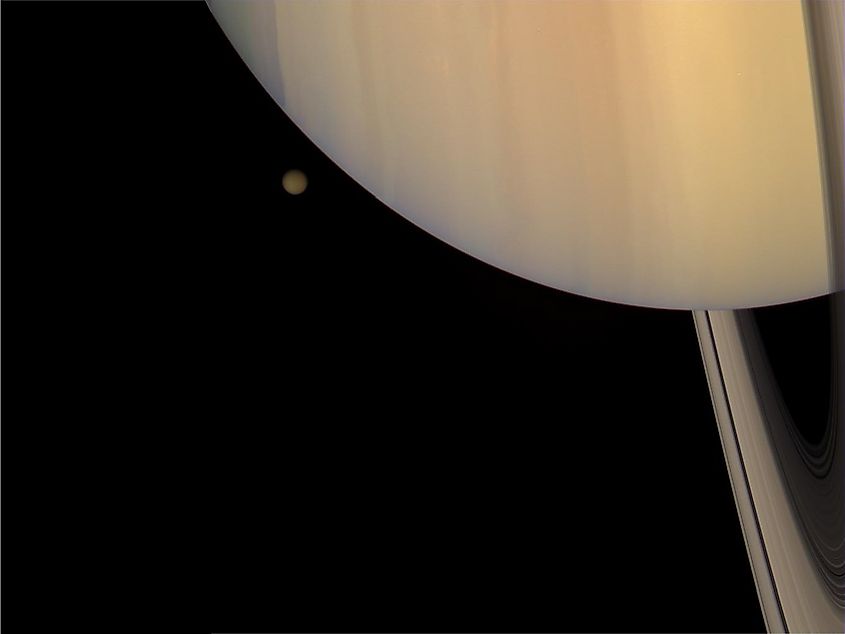
In this section:
- Titan
- Enceladus
- Mimas
- Iapetus
- Hyperion
Saturn is home to the largest moon system in the solar system. There are an estimated 82 moons in orbit around Saturn, 53 of which have been confirmed. Titan is the largest of Saturn’s moons, and it has been the subject of intense study for over a century. It was realized early on that no surface features could be observed on Titan, which led some astronomers to accurately conclude that the surface of Titan is hidden from view by a dense atmosphere. This made Titan the first moon to be found possessing an atmosphere comparable in density to our own. How a moon could have such a dense atmosphere posed a mystery. After all, Titan has a significantly denser atmosphere than even Mars, and Mars is significantly larger than Titan and thus should have held onto a denser atmosphere than Titan. It turns out that the atmosphere of Titan is dominated by hydrocarbons such as methane and ethane. These compounds are extremely dense in Titan’s atmosphere due to the frigid temperatures, which allows them to remain part of Titan’s atmosphere rather than escape into space. Furthermore, the atmosphere maintains its density even under Titan’s weak gravity due to the fact that Titan is actively recycling material from the atmosphere and back. These natural cycles help to maintain the atmosphere of Titan. When the Cassini spacecraft first arrived at Saturn in the early 2000s, scientists deployed the Huygens probe to the surface of Titan. The mission would provide astronomers with their first up close views of Titan’s surface, and they revealed a truly alien yet somewhat familiar landscape. Like on Earth, scientists found clear evidence of rivers, lakes, and even large seas on Titan. These structures, however, do not contain the water that we’re familiar with on Earth. Rather, the frigid temperatures on Titan allow for hydrocarbons to exist in liquid form on the surface. Titan’s rivers do not contain water, they contain liquid methane and ethane that actively flows across the surface. Stranger still, some of the hydrocarbons can evaporate into the atmosphere and then precipitate back as hydrocarbon rain. It literally rains on Titan. This process on Titan, sometimes called the methane cycle, is very similar to the water cycle here on Earth.
Enceladus is one of the most intriguing moons of Saturn. It was discovered by astronomer William Herschel in 1789 and was named Enceladus by his son. Despite its existence being known for over a century, everything about Enceladus was a mystery until the Voyager flybys in the early 1980s. What astronomers found was a world unlike anything they’d ever seen. The surface of Enceladus was covered in ice, making Enceladus the most reflective world in the solar system. The south pole seemingly lacked craters, and large cracks and fissures were found across the surface. Despite the success of the Voyager missions, a lot was still unknown. Hence, NASA planned the Cassini mission. Cassini would orbit Saturn for over a decade, taking some of the most stunning images of the ringed planet and its moons. Enceladus was one of Cassini’s more frequently visited worlds. Cassini revealed a world stranger than science fiction. During its frequent flybys of Enceladus, Cassini observed something strange. The South Pole of Enceladus seemed to be ejecting some kind of material into space. Closer observations revealed that Enceladus was in fact releasing mass amounts of water vapour into space. This water was being blasted out of gigantic geysers located around the South Pole of Enceladus. The region was named the Tiger Stripes after the large stripes streaking across the South Pole. Geysers are generally indicators that a world is volcanically active, which suggests that the interior of Enceladus is very warm. This came as a surprise, being that tiny worlds such as Enceladus tend to release their heat to space fairly quickly. That’s why most moons, such as our own, are covered in craters and lack any evidence of recent activity. For such a small world to be so active suggests that Enceladus is being supplied with large amounts of energy. With the sun being too far away to supply enough heat, astronomers looked to Saturn. As Enceladus orbits Saturn, the gravity of the gas giant pulls on the small moon. This gradually flexes Enceladus, stretching the moon out when it’s far and compressing it when it’s close. This flexing creates friction within the core of Enceladus, which melts subsurface rock and releases heat. This heat melts subsurface ice to form a subsurface ocean that could be ten times deeper than the deepest ocean on Earth. The warm subsurface ocean partially melts ice on the surface, creating the large cracks and fissures. As heat rises to the surface, it also causes large amounts of water to burst through the ice in the form of geysers. Some of this water vapour falls back and becomes a coating of fresh snow on Enceladus. The rest of the material escapes into space and becomes part of Saturn’s E-Ring.
Mimas is one of Saturn’s many moons, being the seventh moon discovered around Saturn by William Herschel in 1789. Having a diameter of only 250 miles (400 kilometres), Mimas is the smallest moon in the solar system that is still able to mold itself into a sphere under its own gravity. However, it’s not completely a sphere. Rather, tidal forces from Saturn and other moons cause Mimas to have an elliptical shape that is so extreme it’s even visible in certain images. Like our moon and most others, the surface of Mimas is covered in impact craters, the most notable of which is 130 km across, comprising about a third of the moon’s total surface. Relative to the size of Mimas, this crater is truly enormous. If a crater of relative size were placed on Earth, it would be about the size of Australia. Mimas is a relatively low density moon, suggesting that Mimas is composed mostly of ice with smaller amounts of rock.
Hyperion is one of Saturn’s strangest moons in terms of appearance, especially as it looks more like a sponge than a moon. Hyperion is only 84 miles (135 kilometres)in diameter, and unlike most moons, Hyperion isn’t tidally locked towards its planet, meaning that one side isn’t constantly facing Saturn. However, this doesn’t mean it has a stable rotation either. Rather, Hyperion is tumbling around Saturn, with a rotation so chaotic that when Cassini approached the moon, scientists were unable to predict exactly what side of the moon they would see. The surface of Hyperion is covered in craters, yet they have an appearance that is unique among the solar system’s moons. Its sponge-like appearance is likely a result of the moon having an extremely low density. The low density of Hyperion means that when an asteroid impacts the moon, it compresses the surface rather than ejecting material out into space. Material that is ejected almost never falls back to the surface, creating a series of smooth craters. Furthermore, the low density of Hyperion also causes the moon’s surface to be highly porous, and in fact, Hyperion is about 40% empty space.
Iapetus is the third largest moon of Saturn. When Cassini discovered Iapetus in 1671, he noticed something interesting. Cassini realized he was only able to observe one side of Iapetus, with the other appearing too dark to observe. Cassini correctly deduced that one side of Iapetus was much brighter than the other. Cassini also deduced correctly that Iapetus is tidally locked with Saturn. These observations were confirmed centuries later by the Voyager and Cassini spacecraft. Iapetus has often been referred to as the yin-yang moon due to the massive differences in coloration on both sides of the moon. Both sides of Iapetus look like entirely different worlds. There’s nothing else quite like this moon in the solar system. Until the arrival of the Cassini spacecraft, scientists were puzzled as to what caused Iapetus to have such large differences in appearance. At first, astronomers thought that maybe the darker region on Iapetus was simply created as Iapetus passed through surrounding debris. Because the moon is tidally locked, one side would receive the brunt of most impacts while the other would be relatively fine. Astronomers also proposed volcanism as a mechanism. Ice volcanoes could deposit large amounts of organic material that make one side darker than the other. As it later turned out, neither of these explanations were correct. Observations from the Cassini spacecraft revealed a different process at play. The differences in coloration on Iapetus means that both sides of the moon absorb different amounts of sunlight. The darker region is warmer while the brighter region is colder. As the darker region warms, sublimation occurs wherein ice is immediately converted to a gaseous state. Once in this state, ice has a much easier time condensing onto the colder surface. As this occurs, ice from the darker region is deposited on the brighter region. Over time, this process created the strange surface features on Iapetus.
| Diameter | 74,898 miles (120,537 kilometres) |
|---|---|
|
Mass |
95.16 Earths |
|
Weight of 100 pound person |
108 pounds |
|
Moons |
82 |
|
Rings |
8 |
|
Distance from the Sun |
886 million miles (1.47 billion kilometres) |
|
Orbital Period |
10,760 Earth days |
|
Rotational Period |
10 hours 40 minutes |
|
Surface Temperature |
Minus 292 degrees Fahrenheit (minus 180 degrees Celsius) |
|
Atmospheric Composition |
97% hydrogen, 3% helium |
|
Surface Composition |
Hydrogen, helium, ammonia, water ice, methane |
|
Discovery Date |
Over 3,000 years ago |
|
Discovered By |
Babylonian astronomers |
